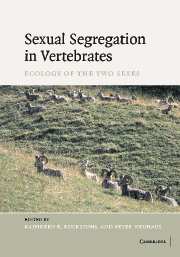Book contents
- Frontmatter
- Contents
- List of contributors
- Preface
- Part I Overview
- Part II Concepts and methodology
- 2 Definitions, hypotheses, models and measures in the study of animal segregation
- Part III Foraging ecology
- Part IV Predator avoidance and reproductive strategies
- Part V Sex-related activities and social factors
- Part VI Sexual differences in ecology: comparisons within different taxa
- Part VII Implications for conservation
- Part VIII Outlook
- References
- Index
2 - Definitions, hypotheses, models and measures in the study of animal segregation
Published online by Cambridge University Press: 04 September 2009
- Frontmatter
- Contents
- List of contributors
- Preface
- Part I Overview
- Part II Concepts and methodology
- 2 Definitions, hypotheses, models and measures in the study of animal segregation
- Part III Foraging ecology
- Part IV Predator avoidance and reproductive strategies
- Part V Sex-related activities and social factors
- Part VI Sexual differences in ecology: comparisons within different taxa
- Part VII Implications for conservation
- Part VIII Outlook
- References
- Index
Summary
OUTLINE
In this chapter, the term ‘segregation’ is clarified, the different types of segregation are defined, and the importance of using terms accurately and consistently is illustrated. The rationale of the key hypotheses relating to causes of different types of segregation is briefly explained and a measure of the degree of segregation (the ‘segregation coefficient’) is presented that is suitable (i) to test hypotheses relating to segregation; and (ii) to make comparisons between populations, species and types of segregation. The chapter concludes with a model to predict the degree of social segregation in a population and ends with three brief empirical examples.
DEFINITIONS OF DIFFERENT TYPES OF SEGREGATION AND DISTINCTION BETWEEN THEM
In many group-living animals, individuals of different classes such as, for example, males and females, subadults and adults, or large and small individuals tend to form separate social groups (e.g. Croft et al., 2003). This is termed ‘social segregation’ (Villaret & Bon, 1995, 1998; Bon & Campan, 1996). Further, classes of animals often differ in their habitat use, which is called ‘habitat segregation’, and/or they differ in their area use, which is termed ‘spatial segregation’ (e.g. Clutton-Brock et al., 1982), whereby ‘spatial segregation’ should be treated as an auxilliary concept (see later). Additionally, the terms ‘diet segregation’ (the classes differ in diet choice) and ‘temporal segregation’ (the classes use the same area but at different times of the year) are used by many authors (e.g. see Chapter 14).
Information
- Type
- Chapter
- Information
- Sexual Segregation in Vertebrates , pp. 11 - 32Publisher: Cambridge University PressPrint publication year: 2006
Accessibility standard: Unknown
- 9
- Cited by
